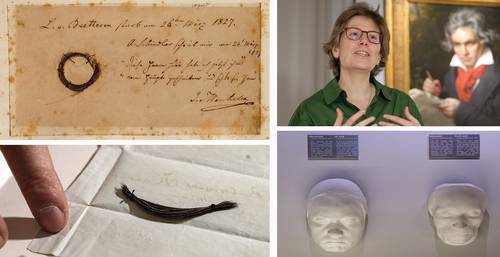
After almost two centuries of the death of Ludwig van Beethoven, the debates about the causes of death continue. A study in the journal Current Biology indicates that a sample of five locks of the composer’s hair revealed that he suffered from a predisposition to liver disease and was infected with the hepatitis B virus; however, the origin of his deafness is still a mystery.Ap y Afp’s photo
A debate among Ludwig van Beethoven’s biographers has persisted around the numerous hypotheses of the cause of his death. Almost two centuries after his death, in Vienna in 1827, the analysis of five locks of his hair made it possible to obtain the genomic sequence that revealed that the genius from Bonn suffered from a predisposition to liver diseases and that he was infected with the hepatitis B virus. However, the origin of his deafness remains a mystery.
scientific journal Current Biology yesterday published an article with the results of the study headed by Tristan Begg, a researcher at the University of Cambridge, in the United Kingdom. One of the most influential and popular musicians in history saw his career as a composer and pianist significantly impacted due to health problems, including progressive hearing loss, recurrent gastrointestinal complaints and liver disease, the document extract states. .
For many years, cirrhosis was considered to have led Beethoven to his grave at the age of 56. In 1802, the conductor and composer himself stated in a letter that only his virtue and art stopped him from committing suicide, since he could not leave the world before producing all the works that he was to compose. He also requested that after his death his doctor Johann Adam Schmidt describe his illness and make it public.
The cause of death remained unclear. In the past, the investigations have dealt with documentary sources, such as letters, diaries, his conversation books and accounts of contemporaries, as well as notes from his doctors. This is added to the autopsy report and the descriptions of the burials of 1863 and 1888, as well as analysis of tissues that are said to come from the musician, including toxicological studies of hair and skull fragments of unknown authenticity.
Re-inspection of his DNA indicates that although we were unable to identify a genetic explanation for the hearing disorder or gastrointestinal problems, we found that she had a genetic predisposition to liver disease. Metagenomic analyzes revealed that he also had a hepatitis B infection for at least months before his death.
.
genomic sequence
Coupled with that predisposition and hints of alcohol dependence, the researchers offer a plausible explanation for Beethoven’s severe condition, culminating in his death, which was attributed to cirrhosis. From the summer of 1821 he began to show symptoms of liver disease and at least two bouts of jaundice.
The article, of about 40 pages, indicates that the study of the remains of the composer is for elucidate the possible genetic causes and underlying infections of their diseases
. The analysis incorporated improvements in the methods in small amounts of historical hair, which allowed obtaining the genome sequence.
Similarly, it is mentioned that in toxicological investigations of hair it is argued that the health problems were caused or aggravated by lead poisoning and that at the end of his illness he was administered opiates and mercury for a hypothetical syphilis infection. We now conclude that these findings do not apply to Beethoven.
.
For the scientific inquiry, eight locks of hair attributed to the Bonn genius were used, five of which came from a European man and were considered to be certainly authentic. Samples were obtained from public and private collections.
In addition to the University of Cambridge, the San José Beethoven Center and the American Beethoven Society of California, in the United States; KU Leuven University, Belgium; the University of Bonn, the Beethoven-Hauss of Bonn and the Max Planck Institute for Evolutionary Anthropology, in Germany. The text includes a long list of specialist collaborators in the United States, Europe and Australia.
